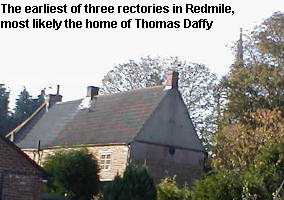Vicar of Redmile
1666 - 1680
Under Construction

|
Vicar of Redmile 1666 - 1680 Under Construction
|
 |
DAFFY, THOMAS (d 1680), inventor of Daffy's 'elixir salutis,' was a clergyman, who in 1647 was presented by the Earl of Rutland to the living of Harby Leicestershire. His conduct as rector appears to have given offence to the Countess of Rutland, a lady of puritanical views, and in 1666 he was removed at her instigation to the inferior living of Redmile in the same county. There he remained to his death, which occurred in 1680. In what year the medicine by which Daffy's name has been handed down was invented is not known, but the following passage from Adam Martindale's 'Autobiography' (Chetham Society's Publications, iv. 209) seems to show that in 1673 (the year in which Adam's daughter Elizabeth Martindale died of a severe cold and cough) it had already achieved considerable reputation: That which seemed to doe her most good was elixir salutis, for it gave her much ease (my Lord Delamere having bestowed upon her severall bottles that came immediately from Mr. Daffie himself), and it also made her cheerful; but going forth and getting new cold she went fast away. I am really persuaded that if she had taken it a little sooner in due quantities, and been carefull of herself, it might have saved her life.'
In an advertisement inserted by Daffy's daughter Catherine in the 'Post Boy,' 1 Jan. 1707-8, it is stated that during the inventors lifetime the elixir was sold by his son Daniel, an apothecary at Nottingham, and that the secret of its preparation was also imparted to his kinsman Antony Daffy. The widow of the latter seems to have disputed Catherine's right to call herself proprietress of the popular soothing syrup. Thomas Daffy's eldest son, who bore the same name. and in 'Gent Mag.' vol.lxxxv, pt.ii. 493 is confused with his father, graduated M.A. at St. John's College, Cambridge, in 1673, and became headmaster of Melton Mowbray school.
(Nicols's Leicestershire, vol.ii.pt.i.pp302,422; Notes and Queries, 3rd ser. iv.77.)
DAFFYS ELIXIR
Daffy's elixir was one among many self-help remedies sold commercially during the eighteenth century, that have been dubbed 'quack medicines' owing to their dubious chemical qualities and curative powers. Others that have not been
singled out include: Thompson Ague Tinc're, GODFREYS CORDIAL, Dr. Becket's Restorative, DR JAMES POWDERS and Dr.
Armstrongs Pills (Fissell, 1991, p47). Characterstic of other quack medicines, daffy's was promoted as a general
pick-me-up and universal treatment suitable for all illnesses. Promoters of daffy's often chose not to reduce their
potential markets by associating the product with any particular illness, although the usual price of 1s. 3d. would have made this beyond the pockets of many people. This is illustrated by an advertisement placed in the Manchester Mercury in
1757 in which daffy's is described as the: "Original Elixir", "so much approved of in Town and Country, which has
perform'd such number of great cures, when all other Medicines have failed, recommended by several eminent
Physicians..." Note also that as in advertisements for other quack medicines attention is given to prestigious patrons
of the product. This advertisement also has the characteristic attack on other "quacks" seeking to counterfeit this
exceptional product: "... the Above Coat of Arms, Elixir and Cures done by it have been counterfeited by J. Eyres of
Warrington, Freeman of the Borough, Martin of Leicester, Whitworth of Manchester; Russel in Queen Street, London, and
these ignorant Quacks who know nothing of the preparation..." Such marketing techniques were used to elevate the
credibility of the product and the promoter in the public's mind (Porter, 189 & 191)
The OED definition states that daffy's was first produced as a remedy for tooth ache, particularly for teething babies,
by a seventeenth-century English Clergyman, Thomas Daffy. However, the accompanying quotation (1680) is contradictory as
the inventor's name was given as Anthony Daffy. A later OED quotation (1857) confirms that a product called daffy's
elixir treated tooth ache. Our sources demonstrate that this was a generic name applied to different remedies over
time, but that it was first introduced and extensively formulated as a laxative. In the rare event of a curative
function being given in our newspaper advertisements for daffy's it is singled out as a cure for stone and gravel. This
is verified by our RECIPE sources. For example a recipe of 1700 for "True Daffy" lists the following common ingredients,
many of which were purgatives: ANISEED, FENNEL SEED, PARSLEY SEED, SPANISH LIQUORICE, SENNA, RHUBARB, ELECAMPANE, JALAP,
SAFFRON, MANNA, RAISIN, COCHINEAL, BRANDY. A chemical analysis carried out in the 1940s of a bottle of daffy's that had
been excavated, confirmed that this was a laxative that would have been made largely from alcohol, with SENNA as a chief
ingredient (Richardmond & Webster, 36). One of the most common forms of alcohol used was GIN; hence the slang name
daffy's for gin.
Additional information
OED earliest date: 1680
Found made from ANISEED, COCHINEAL, RHUBARB
References
From University of Wolverhampton
Daffys Elixer -
Small - Mint condition - 1820 - £140
Fissel (1991), Patients, Power, and the Poor, 45, 47
Porter (1989), Health for Sale, 116
Richmond & Webster (1950), Excavations, 36
THE DICTIONARY OF TRADED GOODS & COMMODITIES 1550-1800
Recently offered for sale by SOMERSET AND DEVON ANTIQUE BOTTLE COLLECTORS CLUB
1705 reference to daffy's Elixir at Manuscript Cookbook of D. Petre, 1705 (12)